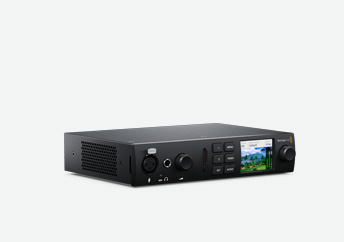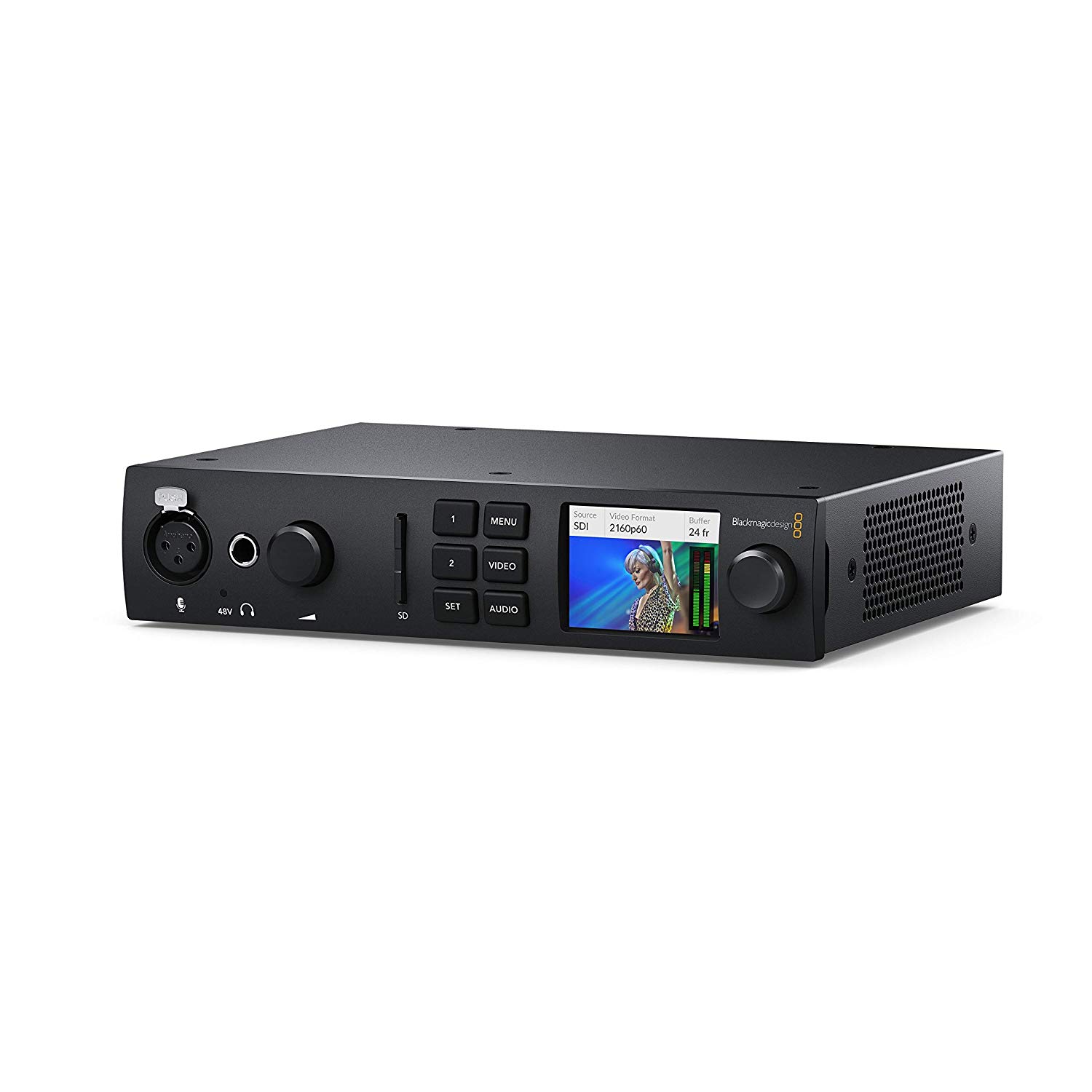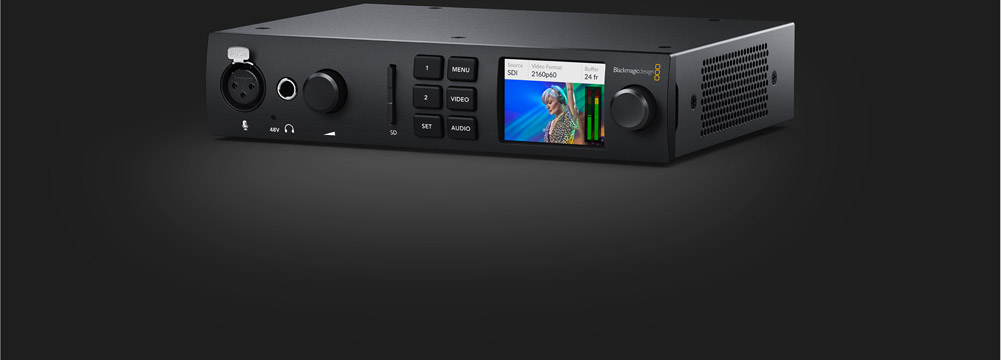- Blackmagic Design Ultrastudio Mini Recorder
- Blackmagic Ultrastudio Express Driver
- Black Magic Design Ultrastudio Express Driver Machine
- Black Magic Design Ultrastudio Express Driver Mac Download
Postproduction technology is changing with the shift to file-based workflows, Thunderbolt data paths and adoption of 4K. To address the varied needs of clients ranging from one-man-band shops to large facilities, Blackmagic Design has developed the UltraStudio Thunderbolt product family. The line includes the low-cost Mini Recorder and Mini Monitor modules at one end and UltraStudio 4K Extreme at the other. I tested the UltraStudio 4K and UltraStudio Express, which sit in the middle of the product line.
Two SD cards are included with the device that feature the following Blackmagic applications: Media Express, Disk Speed Test, LiveKey, Blackmagic Desktop Video Utility and Blackmagic driver on Mac OS X/Windows 7, 8, and 10/Linux, and DaVinci Resolve (formerly known as DaVinci Resolve Lite). 40 Gbps Thunderbolt 3 Interface.
- UltraStudio has been specifically designed for the Mac platform's unique needs and is supported by a huge range of popular video software. The included drivers have been optimized for high performance video, plus the features needed for editing software such as DaVinci Resolve, Final Cut Pro X, Premiere Pro CC, and Avid Media Composer.
- Software Included: Media Express, Disk Speed Test, Blackmagic System Preferences and Blackmagic driver, Mac OS X and Windows Drivers. Internal Software Upgrade: Firmware built into software driver. Software driver loads upgrades at system start or via updater software. Software Applications.
- The Blackmagic Design UltraStudio 4K Thunderbolt 2 is an external 1RU/table-top I/O device with two 20Gb/s Thunderbolt ports.
- Blackmagic Desktop Video is a free and quite powerful collection of applications, plug-ins and drivers designed to provide you with extended support for the DeckLink, Intensity and UltraStudio.
UltraStudio 4K
UltraStudio 4K is a rack-mount unit that’s designed for facility or mobile truck installation. It is 1-RU tall, connects to a Mac or PC via a single Thunderbolt cable, and is compatible with Thunderbolt and Thunderbolt 2 protocols. All connections are on the back plane and the fan vents through the sides for tight rack spacing. The sleek front surface features a small confidence LCD display and six illuminated audio/video input selector buttons.
The UltraStudio 4K front panel features a small LCD confidence
display and illuminated input selection buttons.
Blackmagic Design Ultrastudio Mini Recorder

As a 4K unit, it supports numerous 4K UHD, 4K DCI, 2K, 1080p, 720p, NTSC and PAL formats and frame rates. The back panel connections cover pretty much everything, including SDI, HDMI, composite and component analog video, and AES digital audio, as well as XLRs for timecode and two channels of analog audio. If you need more than two channels of audio, then that is designed to be passed as embedded SDI or over AES. There’s a Thunderbolt loop-through as well as two SDI loops for the two SDI input connections. Finally, UltraStudio 4K supports connection to a VTR, so it includes a standard 9-pin remote connector.
Blackmagic Ultrastudio Express Driver
UltraStudio 4K includes connectivity for many analog
and digital ports.
Like other Blackmagic rack units, UltraStudio 4K does not come with a power cord. This is an international, multi-standard system that can be installed into 120-240V/50-60Hz electrical systems. Since power plug configurations vary around the world, Blackmagic has opted to have you provide your own. In the United States, any standard three-prong power cord—like the one on the back of most monitors—should fit. Thunderbolt cables are also not included.
UltraStudio 4K Extreme includes hardware-based ProRes
and H.265 encoding and 12G-SDI bandwidth, which
supports up to 4K 60p over a single BNC cable.
UltraStudio 4K is built around a chipset that supports SDI, 3G-SDI and 6G-SDI bandwidths—essential for high frame rate 1080p, stereo 3D, 4:4:4 and 4K workflows—yet these units are still compatible with SD and HD infrastructures. 6G-SDI (6 Gb/s) is fast enough for Ultra HD video at up to 30 fps to be passed over a single BNC cable. In standard HD operation, the two SDI outputs can be configured for a full HD signal and a second downconverted one. This unit doesn’t up- or downconvert between 4K and HD or SD, but if you are working in DCI versus UHD sizes, UltraStudio will up- or downconvert to the nearest 4K size—up to 4096 or down to 3840 pixels wide.

In the UltraStudio product line, the big brother is UltraStudio 4K Extreme, a larger, more powerful unit with 12G-SDI bandwidth. That’s enough for 4K 60p video over a single BNC cable. It features even more connections, a larger LCD display, dual power supplies and built-in hardware encoding for H.265 and Apple ProRes (on Mac OS X). 4K Extreme not only connects via Thunderbolt, it can also connect to a PCIe host using a small PCIe adapter card. This is the same unit that Avid will be selling as Avid DNxIO. That version will embed hardware encoding of the Avid DNxHR codec and will be sold and supported through Avid and its reseller channels.
UltraStudio Express
UltraStudio Express is the ideal companion for laptop
editing operations.
If you need something portable, UltraStudio Express fits the bill. It’s an SD/HD unit connected and powered by a single Thunderbolt line. The small aluminum housing includes SDI and HDMI I/O connectors, and a multi-pin port for everything else. The unit ships with two breakout cables for a variety of analog audio and video connections. One breakout cable features professional BNC and XLR connectors, while the other uses RCA plugs. The “pro” cable also includes a 9-pin VTR remote. UltraStudio Express is fanless and small, so it’s a perfect laptop companion. If you need only SDI or HDMI connectivity, then there’s no need to connect either of the breakout cables.
Like the larger 4K systems, UltraStudio Express supports a wide range of SD and HD standards and offers some conversion capabilities. On input, it can convert HD to SD or SD to HD; on output, from HD to SD or 720 to 1080. UltraStudio 4K adds SD to 720 or 1080 conversion on output. While there is a good range of conversion options on both systems, they don’t cover every combination of frame rates, pull-downs, etc.
Both units are driven by Blackmagic Design’s Desktop Video software. The installer includes drivers, the Desktop Video Utility, Media Express and Blackmagic Disk Speed Test. On a Mac, you access the Desktop Video Utility through System Preferences to set up the unit. Media Express is a software application for video capture, playback, mastering and management. This is important for Final Cut Pro X users, since that NLE is designed only as a file-based editor and does not have its own tape capture or output modules.
Diving In
Since these are Thunderbolt devices, I tested both the UltraStudio 4K and Express units on my Retina MacBook Pro. I connected the output to a Panasonic 1080p monitor via SDI and later to my home Samsung display using HDMI. Thunderbolt is hot-swappable, so it was easy to go back and forth between units. The Blackmagic Desktop Video Utility quickly recognized each unit for fast reconfiguration of settings if needed.
The software installer includes Media Express for video capture
and print-to-tape functions that are independent of
any editing application.
Both units work with a wide range of Apple, Adobe, Avid and Blackmagic Design software—regardless of whether you are using Blackmagic Resolve, Adobe Premiere Pro CC, Apple FCP X or Avid Media Composer, the system has you covered. Check the specs on the web site, but a ton of other applications—including Autodesk Smoke, Blackmagic Fusion and Adobe Photoshop—are also compatible.
I spent a fair amount of time running both Apple Final Cut Pro X and Adobe Premiere Pro CC 2015 through both units. These are generally the NLEs I work with today. Naturally I expect DaVinci Resolve to work, but I was pleasantly surprised that Adobe SpeedGrade CC 2015 also works. Enabling Mercury Transmit out of SpeedGrade through Blackmagic hardware had been a bit of an issue in the past, meaning that users had to choose between working with SpeedGrade and AJA hardware or Resolve and Blackmagic hardware. For Blackmagic owners, this dilemma is now gone. Finally, with current hardware, it all works as expected.
How each unit handles 4K depends on the application and what it’s capable of. I have a test clip of Sony XAVC 4K footage (4096 x 2160). When I play it through UltraStudio Express in either Premiere Pro CC or Final Cut Pro X, it will display as 1080 even though the sequence is 4K. That’s because the unit can only output 1080. Both applications are savvy enough to downscale the sequence to 1080, and therefore it plays. Naturally, this taxes the computer, although FCP X had far less trouble than Premiere Pro did.
This was not the case when I connected the larger UltraStudio 4K. When you use Final Cut Pro X, the video output is determined by the settings in the Desktop Video Utility. If you set it to 1080p (to match the monitor), then FCP X will downscale a 4K timeline to 1080p and happily pipe it to the monitor. This isn’t true in Premiere Pro, which overrides the Desktop Video settings. Even if you set it to 1080p, because the unit is capable of handling 4K, Premiere Pro will cause it to be set to match the 4K sequence. If you are working in a 4K sequence, UltraStudio 4K will play it at 4K (one of the 2160p choices). When that happens, the 1080p monitor goes black. So which unit is right for you? You need to take into account the monitors you own and the NLE you cut with. Or you may have to upgrade your monitors.
The Desktop Video Utility is used for quick access and easy
control of hardware settings.
Both units work well. The Thunderbolt loop-through on UltraStudio 4K came in handy by leaving my second MacBook Pro port free. I connected a LaCie Rugged FireWire 800 drive using a FW800-to-Thunderbolt adapter. It was able to play a single stream of 1080p or 4K for a long time without dropped frames or other technical issues. Latency was extremely low over SDI (a bit more over HDMI) and there were no issues with audio sync. The build quality of both units is solid and Blackmagic Design now offers a three-year limited warranty.
The only caveat I would offer is that UltraStudio 4K (and I’m sure this goes for Extreme, too) is an item that should only go in a noisy machine room. The fan is very loud—think hair dryer on low. The nice PR images that show a short rack containing one of these units next to an editor or colorist is not realistic.
Blackmagic Design has come a long way in a few short years to establish itself as a key player in broadcast, production and post technology. If you are considering any of the new Macs or even PCs that employ Thunderbolt, then you’d be hard-pressed to beat these units. They perform well, handle 4K and set the standard for affordability.
Product:Blackmagic UltraStudio Express and UltraStudio 4K
Score:

Pros: Wide format and host application support. Simple configuration and operation. Easy installation with single Thunderbolt cable.
Cons: Power cords not included with rack units. Fans are noisy in rack units.
Bottom Line: An excellent family of products for SD, HD, 2K and 4K media production and post. Ideal for a wide range of users, from small shops to large facilities.
MSRP: UltraStudio Express $495, UltraStudio 4K $995
Subscribe
For more stories like this, and to keep up to date with all our market leading news, features and analysis, sign up to our newsletter here.
Blackmagic UltraStudio Recorder 3G
UltraStudio Recorder 3G is a capture solution featuring 3G-SDI and HDMI connections, with high speed Thunderbolt™ 3 technology. UltraStudio Recorder 3G is pocket sized and powered by its Thunderbolt connection
UltraStudio Monitor 3G and UltraStudio Recorder 3G are two new capture and playback solutions featuring 3G-SDI and HDMI connections plus high speed Thunderbolt™ 3 technology. UltraStudio Monitor 3G and UltraStudio Recorder 3G are extremely portable, pocket sized products powered by their Thunderbolt connections so they can be operated from a computer’s battery or power source.
UltraStudio Monitor 3G and UltraStudio Recorder 3G are two separate products, one for recording SDI and HDMI video, and the other model for playing back SDI or HDMI video. They are extremely tiny designs that are perfect for portable tasks that don’t require both capture and playback in a single device. Their lower cost means the customer can choose to add recording or playback when needed. A good example is when monitoring using NLE software the UltraStudio Monitor 3G would be the perfect choice. A customer who needs simple recording can choose the UltraStudio Recorder 3G.
Replacing older Thunderbolt 2 models, these new models feature Thunderbolt 3 which makes possible greater features, such as more video formats, greater selection of colour space, RGB video formats and lower cost.
They both feature advanced high quality video technology allowing customers to go on location for uncompressed and compressed capture and playback tasks at the highest 10 bit SD/HD quality.

With easy plug and play and incredibly fast transfer speeds of Thunderbolt technology, UltraStudio Monitor 3G and UltraStudio Recorder 3G can be moved easily between computers and can capture from decks, cameras and live video sources, and output to monitors, projectors, media servers and more. This is perfect for editing, compositing, graphics production and unlimited broadcast and post production situations where the highest quality video and true versatility are demanded.
“UltraStudio Monitor 3G and UltraStudio Recorder 3G let you work anywhere because they are extremely compact and are powered from the Thunderbolt 3 connection,” said Grant Petty, CEO, Blackmagic Design. “You can simply plug into any Thunderbolt 3 enabled laptop or a desktop computer and start working. With support for high bandwidth formats up to 1080p60 these are advanced video capture and playback solutions that are small enough to fit in your pocket. There is nothing more portable!”
UltraStudio Monitor 3G and UltraStudio Recorder 3G Features
- Two models, UltraStudio Monitor 3G for playback and UltraStudio Recorder 3G for capture.
- High-speed Thunderbolt 3 port for high quality video processing.
- Built in 3G-SDI and HDMI connections on each model.
- Supports all common SD/HD video formats up to 1080p60.
- Uncompressed and compressed 10-bit 4:2:2 YUV or RGB quality.
- Supports DaVinci Resolve and all other video software.
- Developer SDK available to download free.
Software Included
Media Express, Disk Speed Test, LiveKey, Blackmagic Desktop Video Utility and Blackmagic driver on Mac OS and Windows. Media Express, Blackmagic Desktop Video Utility and Blackmagic driver on Linux.
Software Applications
Black Magic Design Ultrastudio Express Driver Machine
DaVinci Resolve, Fusion, Final Cut Pro X, Adobe Premiere Pro CC, Avid Media Composer, Adobe After Effects CC, Avid Pro Tools, Steinberg Cubase, Steinberg Nuendo, Adobe Photoshop CC.
Black Magic Design Ultrastudio Express Driver Mac Download
Other supported applications include:
The Foundry Nuke, Grass Valley Edius, Sony Catalyst Production Suite, Tools On Air Just: Play & Live & In, Softron MovieRecorder & MReplay, Adobe Flash Media Live Encoder, Telestream Wirecast, Livestream Producer, Resolume Arena, Magix Vegas Pro & Movie Edit Pro Premium, Corel VideoStudio Pro, CyberLink PowerDirector, Vidblaster X & Studio & Broadcast, Uniplay One & CG, CasparCG Server, Magicsoft CG, Xsplit Broadcaster, Imagine Communications Velocity & InfoCaster, DevTek Easy Media Suite, Metus Ingest, Boinx Software MimoLive, Cinegy Capture Pro, vMix Live, Renewed Vision ProPresenter, Ventuz Director, Class X Liveboard & Coral CG, Glookast Capturer, Open Broadcaster Software Studio, Nautilus NEMO3D, Burst Video Webclip2Go & [REC]Marker.